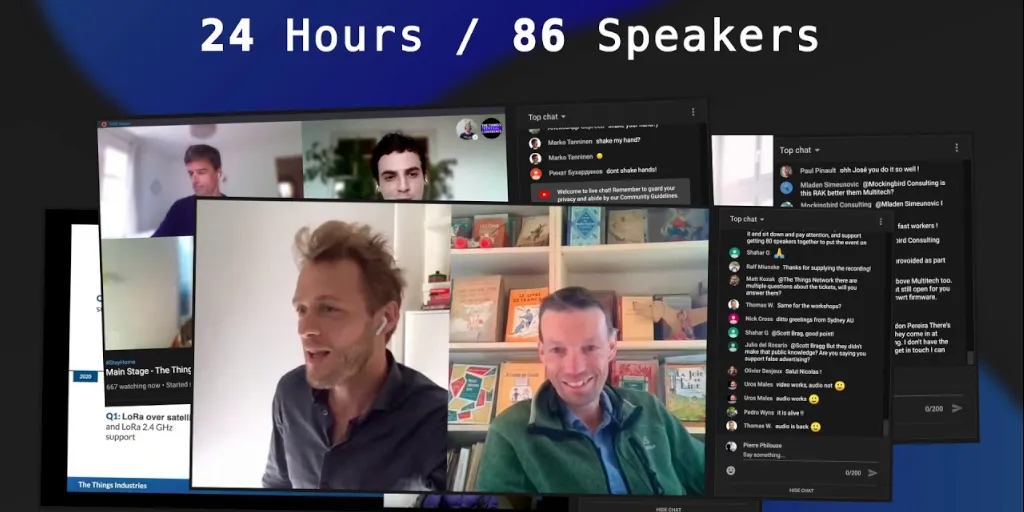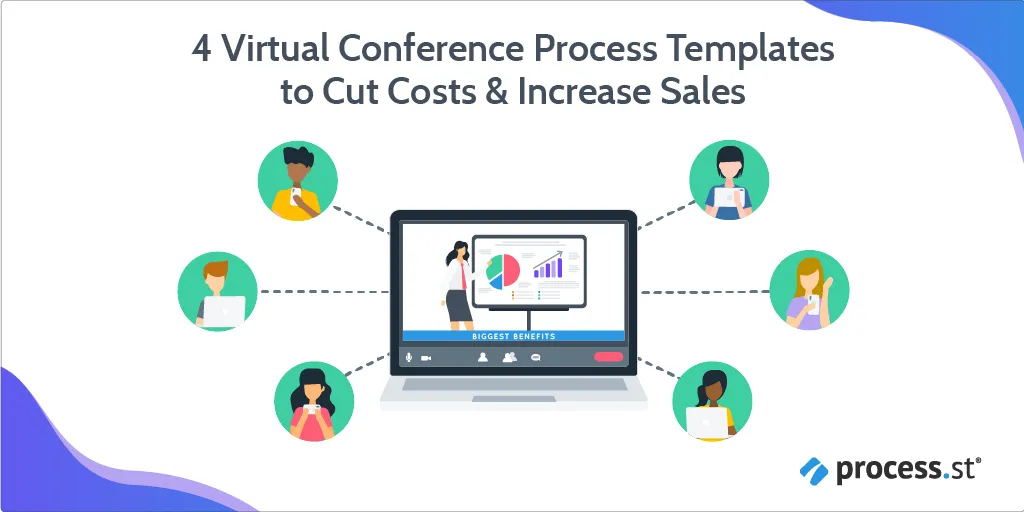4 Virtual Conference Process Templates to Cut Costs & Increase Sales
Blog: The Process Street Blog

I shouldn’t be here.
I should be sitting in a field, sipping a lukewarm cider, waiting for Aerosmith to come on stage and blow me away.
I should’ve been at the Glastonbury music festival; the UK’s (muddier) equivalent to Coachella.
But thanks to Covid-19 I’m not.
I’m stuck in my hot, stuffy office.
Although it’s heartbreaking, I’m not the only person affected by the decision to cancel the biggest event in my calendar, and music festivals and social occasions aren’t the only events to get canned because of the pandemic.
Most business trips, in-person meetings, and big, costly conferences have also been canceled or postponed.
In fact, talking of conferences, the number of canceled conferences is said to be costing the economy billions. As a direct example, the losses from major tech conferences alone have soared beyond $1 billion.
But, before you start contributing to these losses and canceling your own conferences, there is another way.
Welcome to the world of virtual conferences.
As more and more businesses start to think of new, innovative ways to carry on with ‘business as usual’ during this troubling time, this Process Street post takes a look at the virtual conference. Not only is it a stop-gap until the virus disappears and normal life resumes, but it’s a great permanent replacement for the traditional, physical conference.
Join me as we discover the answers to the following questions:
- What is a virtual conference?
- Why run a virtual conference?
- What should I consider when running a virtual conference?
- How do I run a virtual conference (with Process Street)?
Plus! On top of all that, we’ve developed four virtual conference process templates that you can use, for free, to help you plan and run the best, kick-ass virtual conference.
If you’re itching to see them, dive in and take a sneak peek:
Or pop into any of the other templates in this post directly from this list:
- Planning a Virtual Conference Checklist
- Running a Virtual Conference Checklist
- Process for Troubleshooting Virtual Conference Issues Checklist
- Hosting a Live Webinar Checklist
Take that Covid-19! We’re going virtual…
What is a virtual conference?
To explain what a virtual conference is, I first need to define what a traditional, physical conference is.
Traditional conferences

“A conference is generally understood as a meeting of several people to discuss a particular topic” – What is a Conference, eVenues
Conferences are used to bring people and organizations with common interests together, to discuss ideas relating to a specific topic.
Conferences can be any size and held on every subject you can think of – from environmental sustainability and technology to mermaids and clowns.
Talks, debates, and panel discussions are often organized to allow experts to share thoughts, ideas, and information. Attendees can chat, mingle, and network with each other, and most conferences have at least one key speaker who is a respected leader in their field and the main reason people attend.
So that’s what a traditional, physical conference is. What about a virtual conference?
Virtual conferences

A virtual conference is an online version of a physical conference.
Instead of people meeting under one physical roof, they meet in a shared online virtual environment.
Thanks to technology and video streaming services, virtual conferences are similar to physical conferences in that they allow people to gather together, share information, and connect with one another.
Live speakers give talks and invite attendees to participate. Instant messaging tools allow for networking rooms to be opened up for guests to chat, and webinars, digital polls, and quizzes are used to bring the audience together.
But, as great as all that sounds, why would you choose to run a virtual conference over a traditional one?
Why run a virtual conference?
Setting Covid-19 aside for a second, why would you choose to run a virtual conference over a traditional conference?
Surely it’s easier to host a physical conference where people can naturally mingle and network? Surely it’s easier to keep attendees engaged with face to face interaction? Surely it’s easier to manage the conference team and speakers when everyone’s together, in one location?
Well, yes.
However, the benefits of running a virtual conference far outweigh some of the difficulties you may face when you run a conference online.
Let me show you what I mean.
Virtual conference benefit #1: Cut costs
Traditional conferences are incredibly expensive to run.

The average cost to hire a conference venue can range from $950 – $1,250 per hour. And that’s just the cost for the venue. What about accommodation and travel for the conference team and speakers? What about providing food and drink? What about renting tables, chairs, and decorations? What about the cost of printing thousands of conference packs and handouts?
Trust me. It’s expensive.
Hosting a virtual conference, on the other hand, is as cheap as chips.
As the conference is online, no physical venue is needed. Boom! Venue costs are gone.
As there’s no physical venue, no one needs to travel. No one needs food or drink. No one needs a chair to sit on. And no one needs a paper handout or a conference pack. Boom! Boom! Boom! Boom! Accommodation & travel, food & drink, table & chairs, and paper & printing costs – all gone.
In fact, it will cost you, on average, 75% less to run a virtual conference than a physical one.
But it’s not all about lowering costs.
Virtual conference benefit #2: Reach a wider audience
“With all the technological advances over the last 10 years, it’s amazing that anyone leaves their home for anything” – How to Host a Virtual Conference: Everything You Need, OptinMonster
By moving your conference online, you’re opening it up for more people to attend. Not just from your state or country, but from around the world.
Think about it.
Say you wanted to attend a conference on model airplanes (these do exist, I’ve been to one…well, I was dragged to one).

The conference is an eight-hour flight away, so you’d have to pay for flights, take time off work, and find, and pay for, somewhere to stay.
What would you do? You’d probably give it a miss. Right?
But, if you were given the chance to attend the model airplane conference from the comfort of your own sofa, you’d be there in flash.
By offering people the chance to attend your conference, regardless of where they are in the world, you’re opening your conference up to a massive, global audience.
Take Apple for example. They hosted a virtual event to launch the iPhone 11, 11 Pro, and Pro Max. A whopping 1.8 million people, from around the world, attended.
But it isn’t just about reaching more people.
Virtual conference benefit #3: Save the planet
“A recent study by telecommunications company GÉANT showed that when one group of employees held all of their meetings virtually, the team members reduced their overall greenhouse gas emissions from transport by 66%” – How Virtual Meetings Are Saving the Planet, ClickMeeting
We should all be concerned about reducing our carbon footprint. You’ve probably heard about Greta Thunberg, the 17-year-old Swedish environmentalist who refuses to travel on planes and, instead, sails everywhere?

She has the right idea. Although for most of us, this approach is not a practical one. For instance, sailing from the US to the UK to attend a conference would take around 6 – 7 days.
But, if you were to host your conference online, as we’ve discussed, it would negate the need for anyone to travel anywhere.
So, with the elimination of travel alone, you’re already contributing to reducing fuel consumption and CO2 emissions.
Plus, if no one is physically there, there’s no need for paper-heavy conference packs, or printed agendas and handouts. So the amount of paper will be radically reduced.
You can even think about the environmental contributions you can make in terms of the reduction in the wear and tear of clothing!
“Virtual conferences, meetings or events have to be one of the most effective ways that a business can be eco friendly” – Can Virtual Conferences Save the Planet, Michelle Harris
So, do your bit and take your conference online.
Evidently running a virtual conference brings huge benefits to the table, but it might also feel like a daunting prospect.
Allow me to alleviate some fears.
What should I consider when running a virtual conference?
Running a virtual conference is similar to running a physical one.
You need to plan meticulously, hire speakers, invite people to attend, promote the conference, provide entertaining and valuable content, and offer value for money.
But there are three extra considerations to think about when hosting a virtual conference:
- What technology to use
- How to resolve issues on the day
- How to keep it engaging
Let’s look at these in more detail below.
What technology to use when running a virtual conference
As we now know, the evolution of technology has given conferences the power to cut costs, increase audience reach, and help save the planet.
But which technology should you use to host your virtual conference?

With the number of different platforms, apps, tools, and pieces of software out there, specifically designed to help you run your virtual conference, there are too many options for me to properly include in this post, so we’ll revisit this properly another time.
In the meantime, below is a list of the types of technology, and a few examples, that you might want to research and invest in, if you’re planning to host a virtual conference:
Video hosting or live streaming platforms
Take a look at video hosting or live streaming platforms such as Zoom or Vimeo which allow you to display your conference content and enable your attendees to see what’s going on. For more information on how to live stream your conference, this read this article.
Live chat tools
It’s worth investing in instant messaging tools like Slack or Hipchat to enable attendees to easily, and naturally, strike up conversations, chat with one another, ask questions, and network.
Planning software
Planning software such as Hopin or Process Street will help you to plan and organize the details of your entire conference – from the preparation, the on-the-day running of events, and the final wrap-up of the conference. More on this later!
Interactive tools
Tools such as Whova or Run the World can connect to many video hosting or live streaming platforms, and will keep the conference lively, fun, and interactive. They can facilitate live Q&A sessions, discussion boards, virtual meet-ups, and even virtual cocktail parties to keep the social side of your conference alive.
So that’s your technology sorted, what about solving your virtual conference issues on the day?
How to resolve issues on the day
Whether they’re virtual or physical, conferences are stressful.
With the volume of people attending, the number of speakers and sponsors you have to manage, and the various presentations, Q&A sessions, and social and networking events you have to run simultaneously, you’re bound to run into a few problems on the day, no matter how much you plan.
But you probably know how to solve problems. You run conferences all the time and have done for years. You can resolve conflicts and issues with your eyes closed.
So why would this be an extra consideration to think about when running a virtual conference?
Because it’s virtual.
Going virtual has it’s very own set of problems.
You’re attempting to run a conference entirely remotely using new technology – so it can be a little trickier to get to the bottom of problems and find answers quickly.
You don’t have your team standing next to you, ready to fight fires; they might be spread out in multiple locations. You can’t physically check in with your key speakers and hosts. You might suffer with terrible internet connection on the day (this is called sods law!) or your attendees might be clueless when it comes to technology and are unable to access the conference.

But fear not!
To resolve problems as quickly as possible, all you need to do is:
- Make sure each member of your team has a distinct role and set of responsibilities
- Have your team, speakers, and hosts briefed, ready, and on stand-by throughout the entire conference
- Keep the communication lines firmly open
- Continuously test your equipment
- Check-in with everyone constantly
- Have a troubleshooting process in place that everyone has access to (more on this process to come!)
Now you have the technology and you feel confident that you can resolve issues on the day, all that’s left to consider is, how to make your virtual conference engaging.
How to run a virtual conference and keep it engaging
It’s easy to keep an audience engaged when they’re ‘trapped’ in a building and ‘forced’ to listen to speakers, talk to other attendees, and participate in mini-events and discussions.
You don’t have that luxury online.
It’s too easy for attendees to tune out and turn off if they want to.
So, how do you stop them? How do you keep them interested?
Follow these four tips to keep people engaged at your conference:
1. Keep your sessions short
If you run a 3hr session on one topic, people will get bored and log off. Keep each session short and sweet and leave room for questions so you know if you need to provide further information or run any additional talks or presentations on the topic.
2. Provide interactive content
Encourage the audience to participate. Run polls or surveys, include Q&A pods, instigate topical games, ask for questions for the presenters, and host interactive webinars, like this one on automation, hosted by our very own Blake Bailey:
3. Select the right speakers
When selecting your speakers, keep in mind your target audience to make sure you choose people who will keep the attendees listening. Choose a passionate presenter, someone who can capture and hold attention.
4. Hire an experienced host
It’s a good idea to hire someone, or deploy a member of your team, to host the conference. Someone to open and close the conference. Someone to introduce the speakers, and someone who can step in if there’s a technical glitch and keep the audience laughing, not leaving.
So there we have it. We now know what a virtual conference is, what the benefits of hosting a virtual conference are, and what we need to consider when running a successful virtual conference.
But, I imagine you have a thousand questions around how to run a successful virtual conference.
Am I right?
How do I run a virtual conference (with Process Street)?
“For the smooth running of a conference, meticulous planning must be carried out well in advance. All important aspects of the conference must be covered, so it is better to maintain a checklist” – What is a Conference, eVenues
I think it’s clear that running a successful virtual conference, or any type of conference for that matter, requires plenty of planning.
What better tool to help you plan, than Process Street.
Who is Process Street?
Process Street is super-powered checklists.
It’s state-of-the-art business process management (BPM) software that makes recurring tasks fun, fast, and faultless.
Watch this video to find out a little more about who Process Street is and what it can do:
So, you can create templates, run checklists, assign tasks, and automate your workflows by connecting to thousands of apps via Zapier, webhooks, or API integration.
But how can Process Street help you plan and run your virtual conference?
Let’s take a look.
How to use Process Street to plan your virtual conference
Failing to plan is planning to fail, especially when it comes to virtual conferences.
Planning out every aspect of your conference, from start to finish, right down to the last minute, will help you feel in control and able to handle the many curveballs you’re likely to receive during the event.
So, why not use Process Street to create this plan?
You could create a virtual conference planning template, like the one below, and each time you run a conference, run a new checklist from this template.
Planning a Virtual Conference Checklist
You can use this template time and time again, tweaking and improving the process each time you run it. You can add, remove, and check tasks off as you go. You can give your team access to it, set deadlines, and assign individual tasks. You can even get stakeholder approval for certain parts of the conference, like budgets and content.
Click here to access the Planning a Virtual Conference Checklist!
To use this template, click the link above, sign into your account and add it to your dashboard.
If you’re not yet a user, sign up for a free trial.
As part of your planning, you’ll also need to decide what content you want to include at your conference. Remember, it needs to be engaging and interactive.
With this in mind, take a look at the below process for hosting a live webinar.
Hosting a Live Webinar Checklist
If your speakers are planning to host a webinar at your conference, assign this checklist to them so they can plan, prepare, and host an interactive, successful webinar that’s fantastically engaging for your attendees.
Click here to access the Hosting a Live Webinar Checklist!
So these are two processes that you can use, right this second, to help you plan your virtual conference.
Now let’s look at two processes that will help you run a mind-blowing virtual conference.
How to use Process Street to run your virtual conference
As we covered earlier, running a virtual conference can be a minefield.
On top of all the usual details you need to think about when running a physical conference, you also need to be ready for unforeseen technical issues. Plus, without the comfort of having a team within touching distance, a lot of what happens during the conference can make you feel a little nervous and out of control.
So, below are two templates that you can have, for free, to help you navigate the choppy waters of your conference and come out the other side smiling.
Running a Virtual Conference Checklist
Run this checklist on the day of your virtual conference to make sure your team knows what they’re doing, the speakers and hosts are ready to go, each session starts on time and goes without a hitch, your technical equipment works, and, most importantly your attendees have the best experience.
Click here to access the Running a Virtual Conference Checklist!
Process for Troubleshooting Virtual Conference Issues Checklist
Alongside the usual dramas and dilemmas that traditional conferences bring, virtual conferences also provide organizers with technical challenges such as issues with audio, video, connection, or network connections. These issues can be catastrophic to the success of a virtual event and can be difficult to resolve if you’re working remotely, without support from IT experts. Use this checklist to help you resolve the issues you face, during your conference, as quickly as possible.
Click here to access the Process for Troubleshooting Virtual Conference Issues Checklist!
As mentioned earlier, you might want to improve or change these templates to make them specific to your virtual conference.
This is easily done and, to help you out, below are some cracking features that you can use to make your virtual conference templates even more useful:
- Stop tasks
- Dynamic due dates
- Task permissions
- Conditional logic
- Approval tasks
- Embed widget
- Role assignments
If you want to find out more about hosting virtual conferences and events, take a look at these related articles.
Virtual conference related articles
- Marketing Events: Our ToolKit on How to Measure Your Events Success
- Virtual Team: How to Excel at Remote Working (Free Templates)
- Kate Erickson on Niche Marketing, Content Creation and Managing a Virtual Team
- How to Onboard a New Virtual Assistant: 2 Real Processes We Use
- Keep Your Event Running Smoothly: How to Choose Event Management Software
- How to Tighten Up Your Remote Team’s Feedback Loop
- 9 Ways to Ease Your Event Planning
- 8 Remote Team Tools for Maximum Collaboration and Productivity
- Follow-up Email After Networking Event Tips
- Build, Grow and Manage a Virtual Team to Help Run An Entrepreneurial Empire
- 6 ways to go virtual and still scale
- Killer Strategies to Successfully Hire a Virtual Assistant
- How to find, hire, manage, and delegate to a virtual assistant
Or, if reading isn’t your thing, check out this video on The Best Remote Team Tools for Collaboration and Productivity.
So, what do you think? Ready to go virtual?
We’d love to hear if you’ve run any virtual conferences. What was your experience? What technology did you use? Who knows, you may even get featured in an upcoming article!
